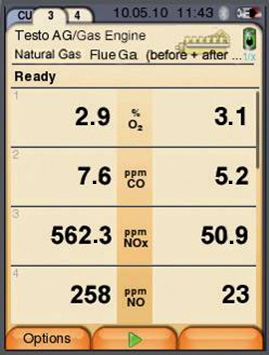 As the new federal guidelines for testing stationary Reciprocating Internal Combustion Engines (RICE) make their way into the field, they generate questions about how to comply with the many different scenarios. The National Emission engine testingEmission Standards for Hazardous Air Pollutions (NESHAP) 40 CFR subpart ZZZZ (aka "quad Z") addresses one type of engine and different types of testing criteria. The New Source Performance Standards (NSPS) subpart JJJJ (aka "quad J") addresses still another set of engines and testing criteria. Needless to say, navigating through the EPA requirements, and realizing that every engine and engine site is different, results in a complex testing determination. To further compound the complexity, as of this writing EPA is reconsidering the requirements of some diesel and emergency engines. For the latest information on regulations, feel free to check out the emission testing links page on testo350.com.
As the new federal guidelines for testing stationary Reciprocating Internal Combustion Engines (RICE) make their way into the field, they generate questions about how to comply with the many different scenarios. The National Emission engine testingEmission Standards for Hazardous Air Pollutions (NESHAP) 40 CFR subpart ZZZZ (aka "quad Z") addresses one type of engine and different types of testing criteria. The New Source Performance Standards (NSPS) subpart JJJJ (aka "quad J") addresses still another set of engines and testing criteria. Needless to say, navigating through the EPA requirements, and realizing that every engine and engine site is different, results in a complex testing determination. To further compound the complexity, as of this writing EPA is reconsidering the requirements of some diesel and emergency engines. For the latest information on regulations, feel free to check out the emission testing links page on testo350.com.In both the quad Z and J standards, portable electrochemical (EC) emission analyzers are accepted for testing under each regulation. Since the late 1990s, portable EC analyzers have demonstrated that both high accuracy and low cost are achievable. As portable analyzers continue to improve, Testo has been the leader in providing innovative field testing capability and performance.
New Testo analyzer capability
Specific to performance testing of catalysts (under the quad Z) Testo has developed an innovative simultaneous testing solution. The regulation requires pre- and post-catalyst testing of the exhaust gas on a simultaneous basis. The typical solution in the past was to use two separate trucks with separate analyzers. Separate data acquisitions systems were also used to join the data for review and reporting.
Innovative multi-unit simultaneous testing
The testo 350 portable emission analyzer has unique features that greatly reduce the hardware and software needed and make data logging and review easier. Two analyzers can be linked to display the catalyst measurements. It's simple and the cost for this system is also substantially lower than the traditional trailer mounted testing rigs.
The testo 350 system is unique in form and function. It starts by connecting two probes and analyzer
 boxes to the exhaust stack. Each analyzer is specifically configured for the different gas conditions found in pre- and post-catalyst exhaust gas. Then both analyzers are connected to the handheld control unit and the magic begins - the high def. graphic display in the control unit shows the side-by-side measurements. Communication through Testo’s data “BUS” system makes it all possible.
boxes to the exhaust stack. Each analyzer is specifically configured for the different gas conditions found in pre- and post-catalyst exhaust gas. Then both analyzers are connected to the handheld control unit and the magic begins - the high def. graphic display in the control unit shows the side-by-side measurements. Communication through Testo’s data “BUS” system makes it all possible.Data collection and interpretation is much easier when you know the actual pre- and post-catalyst measurement in real time. Managing data is the next critical requirement and Testo takes this capability further in its easyEmission software. Not only can the simultaneous measurement be displayed in a variety of formats with simple two analyzer operation, easyEmission can display measurements of up to 16 analyzer boxes for the ultimate in simultaneous, multi-unit testing.
The testo 350 portable emission analyzer provides extensive testing capabilities unmatched in the industry. Contact Testo for a demonstration of this multi-unit testing and let us show you how easy emission testing can be.


No comments:
Post a Comment